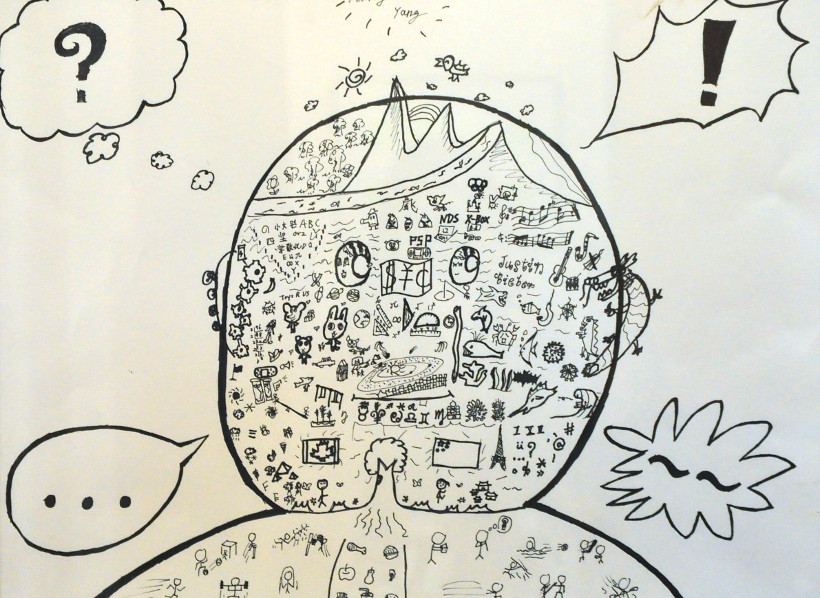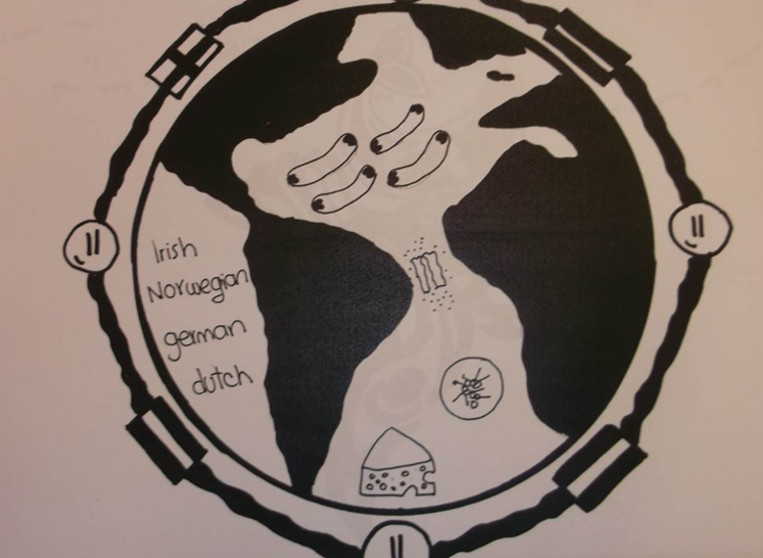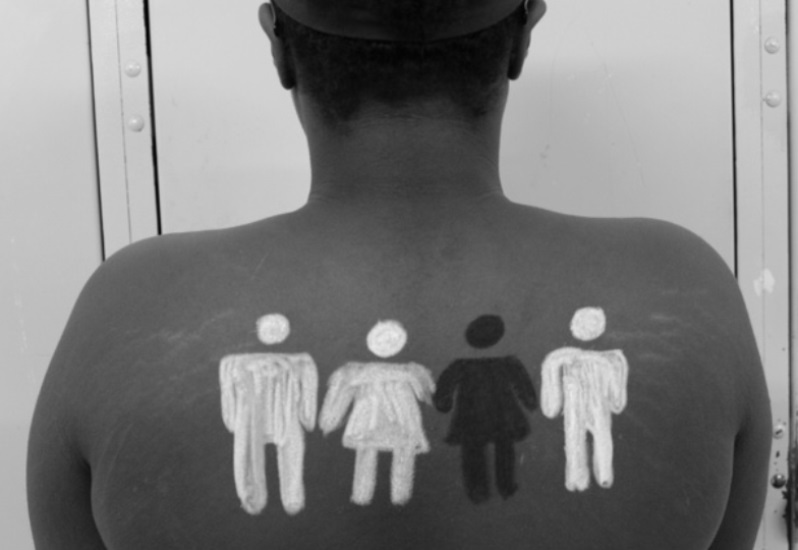Communicating Stories of Identity
Arts Education - Grade 9
This unit of inquiry is not a recipe book but rather a launchpad to inspire new BIG IDEAS. We encourage you to use and/or modify one, or several of the BIG IDEAS below. Adapt it to the grade/ ability level of your students.
Enduring Understandings
We can challenge the status quo and open ourselves to new perspectives and experiences through the arts.
Guiding Questions
How does art communicate personal stories and/or experiences and express who we are?
Mind Opening
Choose or devise practices to encourage students to be open to new experiences and ways of thinking in your classroom. For example, the MindUP in-school program.
Discovery and Inspiration:
Launch the Project
• Introduce the Theme: Present the Enduring Understanding and Guiding Questions using vocabulary that is appropriate for your grade level.
• About Vancouver Biennale: Play a short video.
• Create Project Space: Brainstorm ideas to make the project theme visual and visible using bulletin boards, and/or a project corner to share relevant materials and inquiry questions and processes.
Reference Resources:
• Introduction to Sculpture and Public Art Unit Plan for information on how art has evolved over time and the unique experience sculptures and/or public art brings
• Vancouver Biennale 2014-2016 Exhibition Theme: Open Borders / Crossroads Vancouver
• Vancouver Biennale Legacy Artwork: Walking Figures (Magdalena Abakanowicz, Poland)
• About Artist and Artwork (PDF)
• Paul Gauguin’s painting Where Do We Come From? What Are We? Where Are We Going?
Learning to Learn:
Art Inquiry
Make a visit to Walking Figures and encourage students freely interact with the installation and explore the art piece at different angles individually and in groups. This Art Inquiry process enables the students to practice observing, describing, interpreting, and sharing visual information and personal experiences. Use the Art Inquiry Worksheet to guide and capture their ideas and impressions. Customize or create your own Art Inquiry Worksheet as appropriate for your project and class needs.
Have students look at the work, discuss what the work might be about, and if there are stories of identity that are implied from the work. Have students also consider the meaning of the word journey and be mindful of their own physical journey to the location. How does this journey contribute to the overall meaning of the work?
BIG IDEAS Anywhere educators: View the Walking Figures Guided Tour Video MUTE ON and encourage students to explore at different angles individually and in groups.
Shared Insights
• Sharing Art Inquiry Experience: Ask students to share the Art Inquiry Worksheet responses in class.
• View Guided Tour Video: View the Walking Figures Guided Tour Video again with SOUND ON.
• Artist Themes – Research: In small groups students rotate between information stations detailing the artist’s life and work. Station topics include: (1) education and training; (2) lifetime of artwork; (2) materials and processes; (3) beliefs and values. At each station, students answer questions and complete a task. For example, at the station “life’s work” students might plot the artist’s various installations on a map of the world.
• Artist Themes – Communicating Identity: After learning about Abakanowicz’s history during WWII, discuss the relationship between the identity of the artist and the sculpture. Are all of the figures the same or do they differ? What identity can students imagine for the figures based on specific details and appearances? Challenge students to identify aspects of the figures that communicate aspects of their own identity and facilitate a discussion on how one’s identity is built upon past experiences.
Inquiry Challenges
Art to Communicate a Personal Message/Journey
• Mapping Identity: Have students visually map their own journey and the places they travel regularly – home, school, the park, the mall, etc. What do these places tell us about who you are as an individual and your story?
• Exploring Narrative Art: Have students explore the narrative quality of artwork and how art is often used to tell a story. Show students artwork which imply a narrative or tells a story without giving them the title of the work. Have students discuss individual interpretations and the narrative evoked from the piece.
For example, Paul Gauguin’s painting Where Do We Come From? What Are We? Where Are We Going?
Optional: After an initial discussion, provide students with the title of the piece and explore the new meanings and understandings the title provides. Have students explore other narrative artwork such as: Carole Condé and Karl Beveridge, The Plague, 2009 and artwork from past civilizations, including ancient Egyptian hieroglyphs, Attic Greek pottery, etc.
• Communicating a Story: Using Gauguin’s artwork title as potential inspiration, have students consider what story they want told. Students to choose a story that is important to them to communicate visually. Suggestions: create a book cover or an illustrated book.
Student Creations and Taking Action
Students can communicate their own story through one or more chosen medium – poetry, spoken word, dance, visual art, etc.
Students can decide on individual or group projects to promote their learning to the broader community for long-term influence. The focus being students as learners and communicators, to engage with an audience to get feedback, and ideally, the action is propelled even further. A coffee house/philosopher’s cafe presentation of their personal stories followed by a discussion of how more about a person creates engagement, compassion, camaraderie.
Reflection
• Teacher and students can reflect on their entire learning process by revisiting the Enduring Understanding and relevant Guiding Questions.
• How did the unit of study open inquiry, create cross–curricular learning opportunities and/or apply learning to real life situations? Has this unit of inquiry changed your opinions, values and world view? In what ways, if any, has it helped you grow as a learner?
Ideas for Cross-Curricular Access
• Language Arts – Reading literary texts and writing meaningful personal texts: Read stories of immigrants to Canada, both past and present. Explore the elements of what makes a story – character, theme, setting, etc. Consider who has written these texts, is it written in first person, second person or third person? Have students make connections between the text(s) and personal experiences.
What story do you want told? Have students record their own stories or the story of an imaginary character through writing. A suggestion is to have students write from the point of view of one of the characters in the narrative artwork they explored.
• Mathematics: Reflecting on yourself as a math learner, write your story as a math learner. What are your most memorable positive mathematical moments and negative math moments in your life story? How can you increase those positive math moments and decrease your negative math moments? What local (teacher, peer, school support, community support, family) or global (websites, youtube, online tutors, books, etc,) resources can you tap into to make sure your math story has a happy ending?
• Science – Life Science: Drawing inspiration from Gauguin’s artwork, consider where do we come from? Explore the beginnings of life, reproduction and the ‘journey’ of the cell. Challenge students to represent the stages of the cell cycle in a creative ways such as poster, illustrated storybook, song or poem or interpretive dance.
• Social Studies – Society and Culture: Investigate the daily lives of people in the developing nation of Canada – those in Aboriginal communities, New France and British North America. Explore how their identities were influenced by a variety of factors in their life.
• Economy and Technology, Environment: Have students visually chart major exploration routes on a map to communicate the story of a chosen explorer.
Credits
Written by: Nicola Twa, 2013 UBC Secondary School Teacher Candidate
Edited by: Jennifer Massoud, Secondary School Teacher
©2013 Vancouver Biennale


